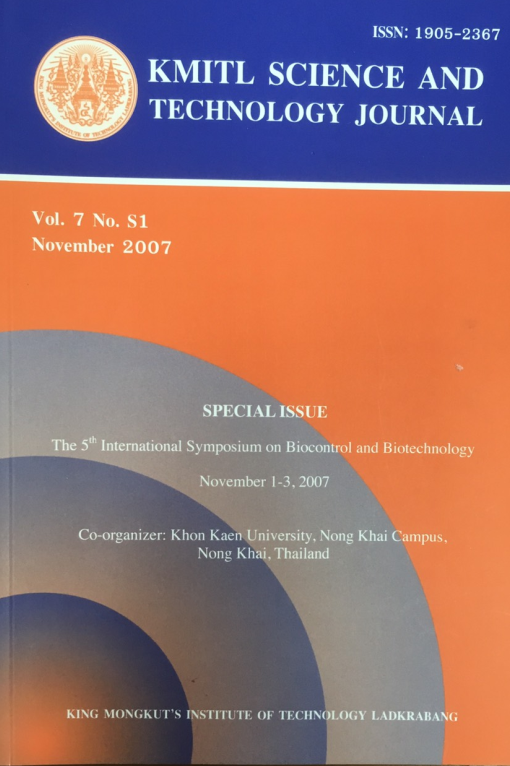PRELIMINARY SCREENING OF BIOSURFACTANT-PRODUCING MICROORGANISMS ISOLATED FROM HOT SPRING AND GARAGES IN NORTHERN THAILAND
Main Article Content
Abstract
Biosurfactants are surface-active compounds produced by microorganisms. These molecules reduce surface tension between aqueous solutions and hydrocarbon mixtures. In this study, we collected soil samples from different hot spring resources in Chiang Mai and Chiang Rai provinces, as well as contaminated soil from garages and screened for biosurfactant-producing microorganisms. Furthermore, we also used stock culturing strains (18 strains of actinomyces and 13 strains of bacteria) from Culture Collection of Excellent Center for Sustainable Development on Bioresources, Chiang Mai University. One hundred and ninety-seven bacterial strains (69 strains from the hot spring and 128 strains from the garage) were isolated and cultured by enriching carbon and nitrogen sources. Each culture medium was sampling to confirm the ability in biosurfactant production. These were conducted using emulsification activity determination (EA), oil spreading technique and parafilm M method. The results reveal that twenty-five strains of bacteria from garage sites presented positive activity which are better than stock bacterial strains. Among these, the emulsifying capacity evaluated by the E24 emulsification index range from 7.8-63.3% EA. In addition, the oil displacement area (ODA) was displayed at 9.62-66.50 cm2 and the collapse of droplets on parafilm M method was showed with the average of 5-8 mm. Interestingly, the bacterial isolate (SCMU106) selected from garage site gave the highest values in emulsification activity, oil spreading and parafilm M determination. This will be further investigated in biosurfactant production for health and cosmetics application.
Keywords: biosurfactant, surface tension, oil spreading, emulsification index
Corresponding author: E-mail: scboi009@chiangmai.ac.th
Article Details
Copyright Transfer Statement
The copyright of this article is transferred to Current Applied Science and Technology journal with effect if and when the article is accepted for publication. The copyright transfer covers the exclusive right to reproduce and distribute the article, including reprints, translations, photographic reproductions, electronic form (offline, online) or any other reproductions of similar nature.
The author warrants that this contribution is original and that he/she has full power to make this grant. The author signs for and accepts responsibility for releasing this material on behalf of any and all co-authors.
Here is the link for download: Copyright transfer form.pdf
References
[2] Desai, J. and Banat, I.M. 1997 Microbial Production of Surfactant and Their Commercial Potential, American Society for Microbiology, 61(1), 47-64.
[3] Gautam, K.K. and Tyagi, V.K. 2006 A Review of Microbial Surfactant, Journal of Oleo Science, 55(4), 155-166.
[4] Makkar, R.S. and Cameotra, S.S. 2002 An update on the Use of Unconventional Substrates for Biosurfactant Proction and Their New Applications, Applied Microbiology Biotechnology, 58, 428-434.
[5] Kitamoto, D., Isoda, H. and Nakahara, T. 2002 A Review of Functions of Glycolipids Biosurfactants-from Energy-Saving Materials to Gene Delivery Carriers, Journal of Bioengineering, 94(3), 187-201.
[6] Mukherjee, S., Das, P. and Sen, R. 2006 A Review of Towards Commercial Production of Microbial Surfactants, Trends in Biotechnology, 24(11), 509-515.
[7] Onanong, P. 2002 Production and Application of Biosurfactant from Bacillus MUV4. M.S. Thesis, Prince of Songkla University.
[8] Rodrigues, L.R., Teixeira, J.A., Mei, H.C. and Oliveira, R. 2006 Physicochemical and Functional Characterization of a Biosurfactant Produced by Lactococcus lactis 53, Colloids and Surfaces B: Biointerfaces, 49, 79-86.
[9] Tabatabaee, A., Assadi, M.M., Noohi, A.A. and Sajadian, V.A. 2005 Isolation of Biosurfactant Producing Bacteria from Oil Reservoirs, Iranian Journal of Environment Health Science Engineering, 2(1), 6-12.
[10] Sarubbo, L.A. 2006 Production and Stability Studies of the Bioemulsifier Obtained from a Strain of Candida glabrata UCP 1002, Journal of Biotechnology, 9(4), 400-406.
[11] Hewald, S., Josephs, K. and Bölker, M. 2005 Genetic Analysis of Biosurfactant Production in Ustilago maydis, Applied and Environmental Microbiology, 71(6), 3033-3040.
[12] Morita, T., Konishi, M., Fukuoka, T., Imura, T. and Kitamoto, D. 2007 Physiological Differences in the Formation of the Glycolipid Biosurfacants, Mannosylerythritol Lipids, between Pseudozyma antartica and Psudozyma aphidis, Applied of Microbiology and Biotechnology, 74, 307-315.
[13] Youssef, N.H., Duncan, K.E., Nagle, D.P., Savage, K.N., Knapp, R.M. and McInernery. M.J. 2004 Comparison of Methods to Detect Biosurfactant Production by Diverse Microorganisms, Journal of Microbiological Methods, 56(3), 339-347.
[14] Plaza, G.A., Zjawiony, I. and Banat, I.M. 2006 Use the Differnet Methods for Detection of Thermophillic Biosurfactant-Producing Bacteria from Hydrocarbon-Contaminated and Bioremediated Soils, Journal of Petroleum Science and Engineering, 50, 71-77.
[15] Krepsky, N., Da Silva, F.S., Fontana, L.F. and Crapez, M.A.C. 2007 Alternative Methodology for Isolation of Biosurfactant-Producing Bacteria, Brazil Journal of Biology, 67(1), 117-124.
[16] Jain, K.K., Collins-Thompson, D.L., Lee, H. and Trevors, J.T. 1991 A Drop-Collapsing Test for Screening Surfactant-Producing Microorganisms, Journal of Microbiological Methods, 13, 271-279.


